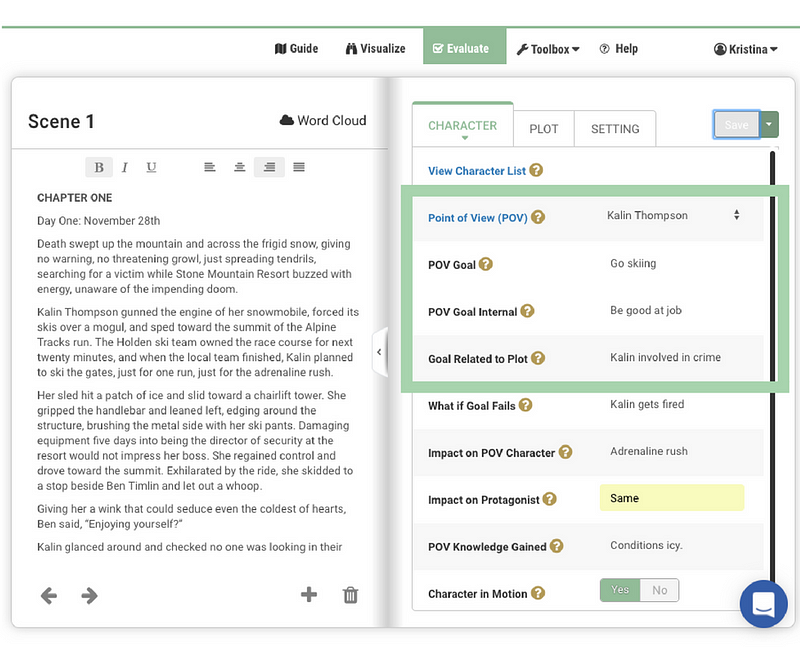Richard North Patterson has some great writing advice. I’d like to take the high-level advice and get practical with it. Let’a talk about a character’s goal.
First we’ll link Patterson’s advice to the point of view character’s goal in every scene.
- Deepen characters — have a goal that relates to the story’s plot.
- Trim writing — cut story elements that don’t relate to the goal or the plot.
- Intensify scenes — have your character strive for a goal that is related to the overall plot.
1. Deepen Characters
Each scene has a point of view character. This character must have a goal for the scene. If there is no goal, then what is the character doing?
To add depth, give the character an internal and an external goal.
The reader is aware of the external goal.
A character’s internal goal is one you may or may not share with the reader. This is something the reader should be able to guess from the story. You as the writer know that the character has an internal goal.
Either goal can be expressed through dialogue, thought, action, or narrative. You need to decide how blunt you want to be when letting the reader know what the goal is. Varying your methods will make the story more interesting to the reader and add depth to your characters.
2. Trim
For each scene, think about how the POV character’s goal is related to the plot of the novel. If you don’t know the answer, perhaps the scene isn’t relevant to the story, or perhaps another character should have the POV for that scene.
Your scene may just need some updating. Can you strengthen the character’s goal? Is there a way to add a goal to the scene so it relates to the novel’s plot? Otherwise, it’s time to trim.
3. Intensify
Whatever type of story you’re writing, there will be a plot. The plot may entail solving a mystery, saving the world, coming of age, or many other things. Only you know the overall plot.
You can intensify a scene using character goals. Here’s a quick example:
The POV character’s goal is to get her car from the service station. That’s not very intense. Ho hum even. But what if we link the goal to the plot.
The plot: The protagonist has witnessed a crime. Her overall goal in the novel it to prove a crime was committed and find who committed it.
The antagonist is trying to find and kill her, but he only knows what car she drives. He doesn’t know where she lives, but he knows where she took her car. In this case, the POV goal of getting the car from the service station may put the character’s life in danger, give an advantage to the antagonist, and intensify the scene.
How StoryTeller Can Help You
Fictionary StoryTeller is a new interactive web app for self-editing fiction that helps writers turn a first draft into a story readers love.
This is a scene from DESCENT (by Kristina Stanley— cofounder of Fictionary)
Finding a murderer is Kalin’s main goal throughout DESCENT. She also has goals within each scene where she holds the point of view.
In this scene below her external goal is to go skiing. Her internal goal is to be good at her job.

The reader is shown Kalin wants to go skiing. She doesn’t achieve this goal because a skier falls and is terribly hurt. She has to put her own wants aside and deal with the situation. This is the start of Kalin’s journey of searching for a murderer. At the time, she doesn’t know she is witness to a crime, she’s only thinking of taking care of the skier. The external goal of skiing places her on the hill at the time the skier falls.
Kalin’s internal goal is to be good at her job. In this scene, she doesn’t know yet this will involve chasing a murderer.
Both goals are linked directly to the overall plot.
The internal and external goal give Kalin depth. It shows she has an active life and enjoys adventure, but it also shows she knows when to put aside her own wishes and be serious about her job.
The first time I wrote this scene, Kalin heard about the accident over the phone. She had no goal. She just reacted by answering the phone. By putting her in an action scene and giving her both an internal and external goal, the scene is intensified.
In my final rewrite of the scene, I trimmed everything that wasn’t related Kalin’s goals or to the plot.
You can use Fictionary to check the character’s goal for each scene is related the plot.

StoryTeller is creative editing software for fiction writers. Transform your story, not just your words. Successful stories depend on your ability to edit, improve, and revise your work. Only when you master story editing, can you master storytelling.
Why not check out Fictionary’s StoryTeller free 7-day trial and tell powerful stories?

